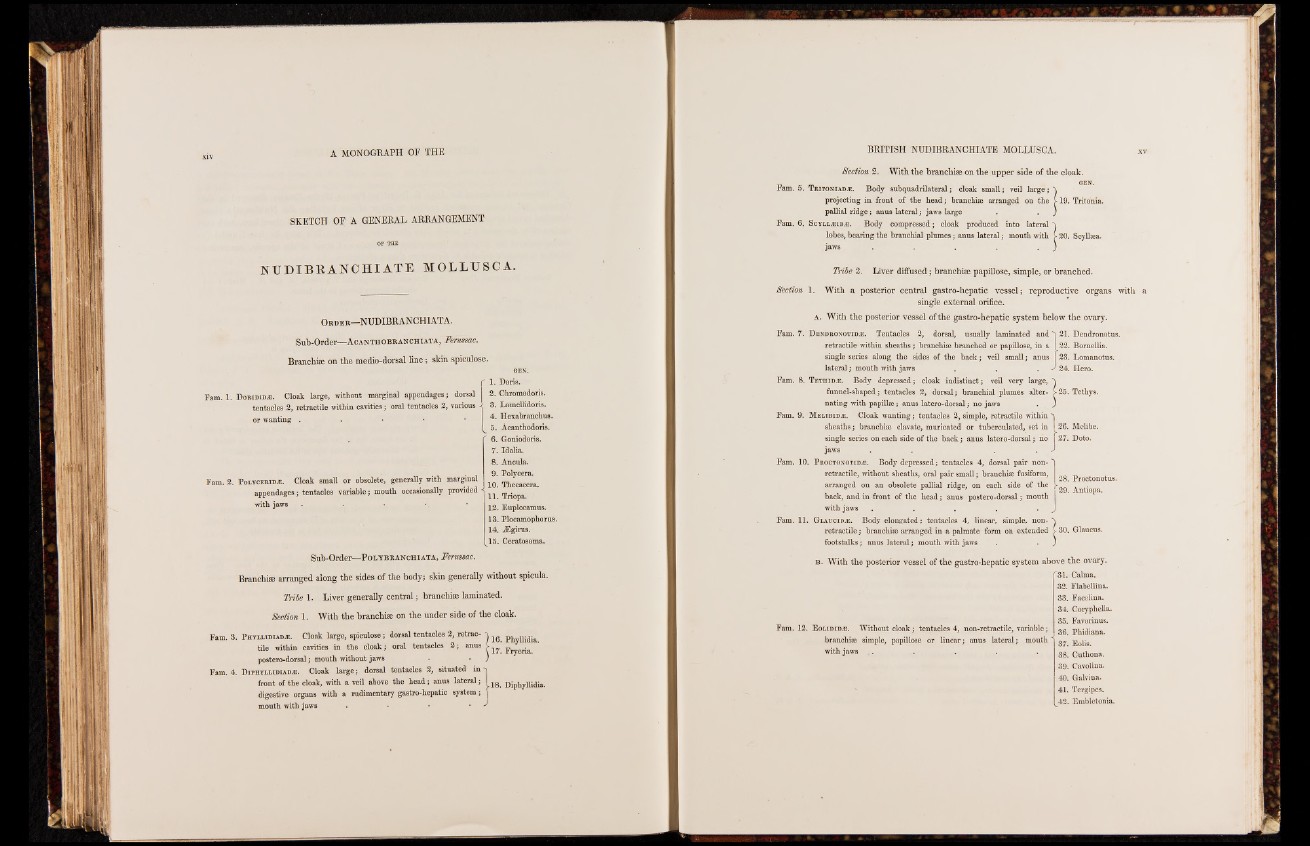
SKETCH OP A GENERAL ARRANGEMENT
NUDIBRANCHIATE MOLLUSC A.
Order—NÜDIBRANCHIATA.
Sub-Order—Acanthobranchiata, Ferussac.
Branchiffi on tbe medio-dorsal line; skin spicnlose.
Fam. 1. D o rid id a . Cloak large, without marginal appendages; dorsal
tentacles 2, retractile within cavities; oral tentacles 2, various
or wanting .
r 1. Doris.
2. Chromodoris.
J 3. Lamellidoris.
4. Hexabranchus.
I 5. Acanthodoris.
Fam. 2. P olycerid.®. Cloak small or obsolete, generally with marginal
appendages; tentacles variable; mouth occasionally provided
with jaws •
6. Goniodoris.
7. Idalia.
8. Ancula.
9. Polycera.
10. Thecacera.
11. Triopa.
12. Euplocamus.
13. Plocamophorus.
14. Ægirus.
15. Ceratosoma.
Sub-Order—Polybranchiata, Ferussac.
Branchise arranged along the sides of the body; skin generally without spicula.
Tribe 1. Liver generally central; branchiae laminated.
Section 1. With the branchiae on the under side of the cloak.
Fam. 3. Phyllidiadas. Cloak large, spiculose; dorsal tentacles 2, retrac- \
tile within cavities in the cloak; oral tentacles 2; anus C ^ ^
postero-dorsal; mouth without jaws . • )
Fam. 4. Diphyiaidiada:. Cloak large; dorsal tentacles 2, situated in "'J&M
front of the cloak, with a veil above the head; anus lateral; I ^ Diphyllidia.
digestive organs with a rudimentary gastro-hepatic system; |
mouth with jaws . • • • ^
Section 2. With the branchiae on the upper side of the cloak.
. I GEN.
ram. 5. Tritoniadas. Body subquadrilateral; cloak small; veil large;
projecting in front of the head; branchiae arranged on the > 19. Tritohia.
pallial ridge; anus lateral; jaws large . . )
Fam. 6. Scyllaeid.®. Body compressed; cloak produced into lateral ^
lobes, bearing the branchial plumes; anus lateral; mouth with >- 20. Scyllaea.
jaws . . . . )
Tribe 2. Liver diffused; branchiae papillose, simple, or branched.
Section 1. With a posterior central gastro-hepatic vessel; reproductive organs with a
23. Lomanotus.
24. Hero.
single external orifice.
a. With the posterior vessel of the gastro-hepatic system below the ovary.
Fam. 7. D endronotid®. Tentacles 2, dorsal, usually laminated and >i 21. Dendronotus.
retractile within sheaths; branchiae branched or papillose, in a | 22. Bomellia.
single series along the sides of the back; veil small; anus
lateral; mouth with jaws
Fam. 8. Tethid®. Body depressed; cloak indistinct; veil very large,
funnel-shaped; tentacles 2, dorsal; branchial plumes alter- >25. Tethys.
nating with papillae; anus latero-dorsal; no jaws . )
Fam. 9. Meltbid®. Cloak wanting; tentacles 2, simple, retractile within 'i
sheaths; branchiae clavate, muricated or tuberculated, set in I 26. Melibe.
single series on each side of the back; anus latero-dorsal; no 27. Doto.
jaws . . . . J
Fam. 10. P roctonotid®. Body depressed; tentacles 4, dorsal pair non- "l
retractile, without sheaths, oral pair small: branchiae fusiform, I _ _ . , . I 28. Proctonotus.
arranged on an obsolete pallial ridge, on each side of the
back, and in front of the head; anus postero-dorsal; mouth
with jaws . . . .
Fam. 11. Glaucid®. Body elongated; tentacles 4, linear, simple, nonretractile;
branchiae arranged in a palmate form on extended >- 30. Glaucus.
footstalks; anus lateral; mouth with jaws . . )
29. Antiopa.
b. With the posterior vessel of the gastro-hepatic system above the ovary.
Fam. 12. Eolidid.®. Without cloak; tentacles 4, non-retractile, variable;
branchiae simple, papillose or linear; anus lateral; mouth
with jaws
"31. Calma.
32. Flabellina.
33. Facelina.
34. Coryphella.
35. Favorinus.
36. Phidiana.
37. Eolis.
38. Cuthona.
39. Cavolina.
40. Galvina.
41. Tergipes.
42. Embletonia.